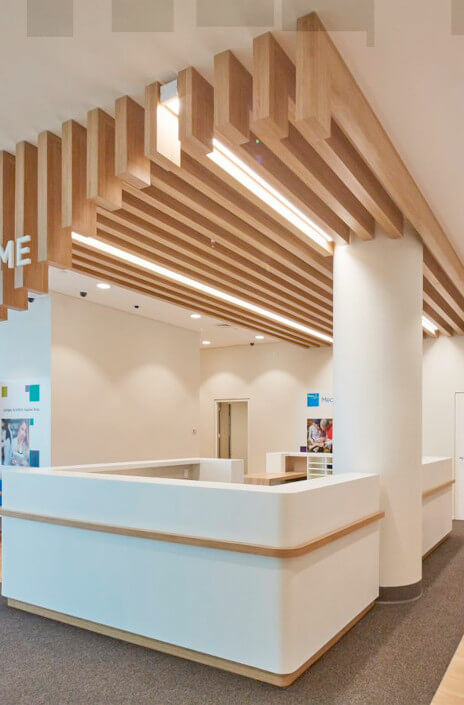
Have you ever entered a store or someone’s home where neon carpeting and/or glaring lights greet you at the door? If you are like 93 percent of the population, this is not an environment that says, “relax and enjoy.” The same can be said for the lighting and colour in your healthcare space, with expertise and science to prove it. So breathe in a pink, calming colour and read more here.
Colour my medical fitout world
According to environmental psychologist, Sally Augustine, PhD., it has long been known that the colours we see in different spaces cause emotional reactions in our bodies and minds. At a very basic level, the psychology of emotions and feelings associated with various colours in our buying habits have been broken down to these:
- Red – energy, excitement, sex, speed and danger
- Blue – dependability, trust, belonging and coolness
- Green – nature, fresh, growth, abundance
- Orange – playful, vibrant, affordable, value
- Yellow implies optimism, warmth, sunshine, cheer, happiness
- Pink – calm, relaxation, peaceful
- Purple – creativity, imagination
- White – empty, boredom
But before you go and paint your medical office in rainbows, we need to dig deeper into how and where we should use these colours. In Entrepreneur Magazine’s “The Psychology of Colour in Marketing and Branding”, its findings state the psychology of colour depends upon the personal experience of the customer, but also the personality and tone of voice of your company’s brand proposition. In fact, it’s not so much the colour itself that makes a difference, but how well that colour complements your brand story.
Leading fitout space researchers, Flonomics, have stated: “According to our data, 93 percent of consumers place visual appeal above sound smell and texture when choosing a product. And 85 percent of customers place colour as the primary reason for why they select a particular product. “ Therefore, you need to consider who your target customer patient demographic is, and then create a colour-scheme within your healthcare space to attract them.
“The reason is we all react fundamentally the same to colours because they help us make sense of our surroundings; indeed, some 80 percent of information reaches our brains via our eyes,” states research in Retail Customer Experience magazine. “The success of a professional space isn’t so much influenced by the chosen colour scheme but by how your target customers react to it.”
Going forward, here are some questions to ask yourself before selecting your medical facility’s colours: Is the area aimed at teenagers? Thirty-somethings? Senior citizens? Then find out how the patients you target react to your brand’s colour and the inside of your clinic. The success of the space depends on how the patient reacts to the environment, ambience and the easy way to navigate the clinic.
Let there be light!
As for lighting, Commercial Architecture Magazine interviewed hundreds of healthcare facilities and lighting design experts, and the results say the following: “Healthcare providers need to recognize that investing in lighting is as important as investing in design and it positively contributes to the patients’ perception of the space and reduces their levels of anxiety on a healthcare environment,”
This seems somewhat of a common sensibility, however, Randy Burkett, FIALD, LC’s president and design principal explains why is it often overlooked. “Lighting, since it is one of the last components that goes into a fitout space is often ‘value engineered’ or cheapened to meet a budget. This might mean sacrificing glare control, superior colour rendering (especially with LEDs), aesthetic or thematic reinforcing light, and so forth,” he said. “And sadly, this can either make or break the patient’s experience, even to the extent that poor/unattractive lighting will affect significantly the experience of your patients at the medical facility. Patients need to feel safe and welcomed at your practice and it’s been demonstrated that appropriate lighting can enhance their behaviour and attitude towards the medical services.”
And with online healthcare sites having an advantage of creating lighting, colour and style with a few website tweaks, with your bricks and mortar store, lighting needs to be highly valued when designing your overall space.
“Healthcare environments need to offer a superior experience—one that’s interactive, interesting, and engaging,” says Sally Lee, business-development manager, Osram Sylvania. “Good lighting design is critical to supporting that goal.”
There are modern advances in lighting design and lighting hardware, with LED-controlled lighting leading the way. These lighting systems allow for the retailer to alter the warmth, hue and direction, often with the simple click of a remote. But this will only happen if you’ve worked with your designer to implement these from the start or during your refit.
Combining light and colour for an optimum patient experience
Lighting in medical is more important than in any other environment. A warm light at the entry to provide a welcoming effect, key focal points at check-in stations or reception areas to provide enough visibility to fill information, and lighting designed to meet the compliance of medical diagnosis in medical areas are not only important for the patient’s perception of clinic but most importantly, for the functionally to physicians and compliance under COI (Cyanosis Observation Index) and tested against Australian Standards (AS1680.2.5)
We understand not everyone is an interior or fitout design expert, but having an understanding of how these two key components work together is an excellent source of knowledge for you. This allow you to work with your fitout design team to ensure you get these right from the start.
